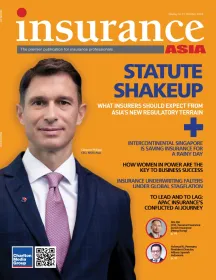
Changes in insurance regulations spark industry transformation in 2024
MSIG Asia CEO hails 2024 as a year of growth for insurers, but cautions on varying regulatory and socioeconomic impacts.
The complex regulatory environment the region of Asia holds stirs the insurance industry all in one motion in this 2024 mixing bowl. For insurers, the pressure mounts as expectations for better offerings are rising, socio-economic factors are gaining strength, and the wealthy population is growing.
Anna Tipping, partner at Norton Rose Fulbright (NRF) Singapore, wrote in a recent publication that requirements vary among jurisdictions regarding the establishment of branches by foreign insurance firms, with some parts of the region permitting only locally incorporated entities.
Foreign direct investment and control regimes — including shareholders and management — may also require regulatory approval for changes in control, whether direct or indirect.
Companies need a strong grasp of regulatory capital frameworks and mandatory policyholder protection regimes. They must also consider group supervision and regulatory oversight on outsourcing.
Spoke with Insurance Asia, MSIG Asia CEO Clemens Philippi said he sees potential room for the industry to grow even as various regulatory changes dampen expectations.
“In 2024, we will see a continued high demand for insurance solutions, which therefore means continuous (but impacted) growth. [The impact] from new insurance regulations from each market can be positive or negative. This could mean growth opportunities,” Philippi said.
In his view, there are three catalysts the industry will see in 2024: higher demand to close the insurance gap, increase in health coverage, and adoption of new technology. Whilst these factors present an opportune time for sprucing up insurance offerings, a hurdle that varies in size for insurers is regulation-related.
“On the regulatory side, it can be a positive influence but it can be a small hurdle for growth. If you look at the population-rich countries like Vietnam, Thailand, Indonesia and our region, they’ve all issued new regulations in the recent past,” MSIG’s top man said.
Vietnam’s new Insurance Business Law
“In Vietnam, you have in 2023, a new insurance law which talks about technical reserves being strengths, foreign ownership, kept risk management information, disclosure being increased and dispute resolution strictly defined,” Philippi said.
Vietnam’s National Assembly passed the new Insurance Business Law on 16 June 2022, bringing significant changes to the law and impacting insurance market development. The new law took effect on 1 January 2023, with certain provisions taking effect on 1 January 2028.
Baker McKenzie firm listed among the changes: the removal of certain compulsory insurance products; the prohibition of insurers denying sales upon qualified policyholder requests; and clearer delineation of fundamental insurance principles.
In addition, it introduced provisions for temporary life insurance, expanded insurer operations and concurrent product sales, and recognised investment from financial and insurance groups.
The law also addressed outsourcing activities, facilitated online sales channels, and enhanced regulations on insurance agency activities, including separate certificates for each product type.
Also, it adjusted the capital adequacy ratio calculation and outlined principles for technical reserves. Other amendments covered foreign ownership, risk management timelines, information disclosure, and dispute resolution mechanisms.
Thailand’s risk-based capital framework
“In Thailand, you have a new risk-based capital framework introduced, which will also have an impact on the company,” Philippi said.
Thailand’s regulatory environment is viewed “less developed” by Fitch Ratings as governed primarily by the Insurance Act and overseen by the Office of Insurance Commission (OIC). The OIC has implemented a risk-based capital (RBC) regime, transitioning to RBC2 in 2019.
Insurers must assess their internal risk governance frameworks and capital adequacy under Enterprise Risk Management and Own Risk and Solvency Assessment frameworks.
The regulator exercises control over product pricing, premiums, marketing, and selling practices.
In cases of insurer insolvency, the OIC intervenes by prohibiting new policy issuance and asset transfers. The regulator also promotes stability and sustainability through a five-year development plan, focusing on fostering competition in the digital economy and enhancing product accessibility to meet consumer needs.
Indonesia raises minimum cap
Indonesia has also introduced new laws regarding various aspects of the insurance industry, including insurance products, distribution channels, reinsurance arrangements, and Sharia-compliant insurance.
“Most importantly, in Indonesia, which is a very fragmented market, there’s also an increase in the minimum capital requirements going over the coming years until 2028, up to $1t,” Philippi told Insurance Asia. “And that, of course, is possibly a catalyst for consolidation over the coming years. So I think this is our outlook for 2024. We will closely follow these developments.”
Fitch Ratings anticipates tougher minimum equity requirements for Indonesian insurers will lead to a more consolidated market, enhancing competitiveness.
It believes new credit insurance regulations could impact micro and consumer lending by banks, as they will now retain 25% of insured default risk, previously borne entirely by insurers. With a fragmented insurance market and numerous insurers, Indonesia may be looking at intense competition that weakens pricing power and profitability.
The Financial Services Authority (OJK) plans to significantly increase minimum equity requirements by end-2026, followed by further raises by end-2028, particularly for insurers offering credit insurance.
Insurers failing to meet these requirements may need to raise capital or explore M&A options. Around 90% of Fitch-rated issuers already meet the 2026 requirement, but 62% may require additional equity by 2028, especially in non-life and reinsurance sectors.
Organic capital generation may suffice for 50% of insurers to meet the 2026 requirement, but meeting 2028 requirements might pose challenges, necessitating other strategies.
The impact of new credit insurance regulations on banks is uncertain; while tightening underwriting standards may improve risk profiles, retaining more risk could have adverse effects. Increased capital requirements for credit insurers may prompt smaller non-life insurers to exit the segment, fostering healthier competition.
The growing middle class
Philippi said he sees the middle class growing in Asia’s emerging markets. This comes in line with the Asian Development Bank's (ADB) publication “Key Indicators for Asia and the Pacific 2022” that even though the COVID-19 pandemic led to an increase in extreme and moderate poverty levels in 2020, projections show a significant decline in extreme poverty in developing Asia, with less than 1% of the population expected to be living in extreme poverty by 2030.
Additionally, the forecast indicates that approximately 7% of the region's population is forecasted to be moderately poor, whilst around 25% may be considered economically vulnerable by 2030. On the other hand, the forecasts suggest that about 43% of the population may achieve economic security, whilst 25% could be classified as middle class by the same milestone.
Meanwhile, the Organisation for Economic Co-operation and Development (OECD) paper on the middle class in Emerging Asia where middle-income classes in these countries exhibit some similarities with lower-income classes in certain aspects.
The resemblance implies that middle-income individuals may support policies aimed at benefiting larger segments of society, including the poor and near-poor. By identifying these commonalities, the paper underscores the potential for middle-income groups to advocate for more inclusive regulations and contribute to social development.
Furthermore, the study emphasises the importance of integrating the needs of the poor and near-poor into policy discussions, particularly in areas where the interests of different income classes may not align. This recognition highlights the need for policymakers to consider the perspectives and priorities of marginalised groups when designing and implementing policies to address socio-economic challenges.
“We see, especially, the continued rise of the middle class to continue to accumulate wealth with a continued demand to close the insurance gap to protect the assets of these young aspiring populations,” the expert said.
Long-term outlook
The MSIG CEO emphasised the importance of closely monitoring external factors such as economic conditions and reinsurance market trends. He noted that the 2022 renewal season witnessed a significant increase in reinsurance prices, driven in part by unforeseen events like a major hurricane in the Florida region, which impacted both American and Asian markets.
Despite these challenges, Philippi expressed confidence in MSIG Asia’s preparedness, attributing their resilience to meticulous risk management practices. The company’s actuarial and claims teams closely track claim developments and inflationary pressures, ensuring that reinsurance partners are kept informed and rates are adjusted accordingly to maintain sustainability.
He is particularly proud of MSIG Asia’s proactive engagement with clients — from SMEs to corporate entities — to address potential risks associated with supply chain disruptions and inflation.
“We work with customers from small and medium enterprises up to large corporates on the sums insured and try to explain what inflation means for that and what under-insurance means if they don't declare the sum insured, proactively and openly,” he said.
Philippi said the company will maintain its conservative investment approach, which has proven effective in mitigating potential shocks, particularly under new accounting standards such as IFRS 17 and IFRS 19.
Still, he underscored the importance of adapting to emerging risks, including climate change and geopolitical uncertainties.
“Another point that we have, of course, on the radar is the weather condition – NatCat events and climate change. We will continuously be focusing on this, and we're going to have some product innovation there,” Philippi told Insurance Asia.
MSIG Asia has already begun innovating in response to these challenges, exploring parametric offerings for industries like farming and investing in predictive climate change modelling fintech startups to enhance risk assessment capabilities.
“On the inflation piece, honestly, I believe we will see a continued flattening. It was a big hype during the 2020 to 2023 renewal season, for the reinsurancers to talk to us about inflation and the impact of that. But we saw that flattening already last year and we think that will continue,” said Philippi.
“But of course, [that] depends again on the global events that are described at the beginning on what will be the outcome for this,” he added.

















 Advertise
Advertise


